Bad Drywall Job: Signs, Causes, & Fixing Your Walls
Author: Omar Alonso | Editor: Omar Alonso
Review & Research: Jen Worst & Chris Miller
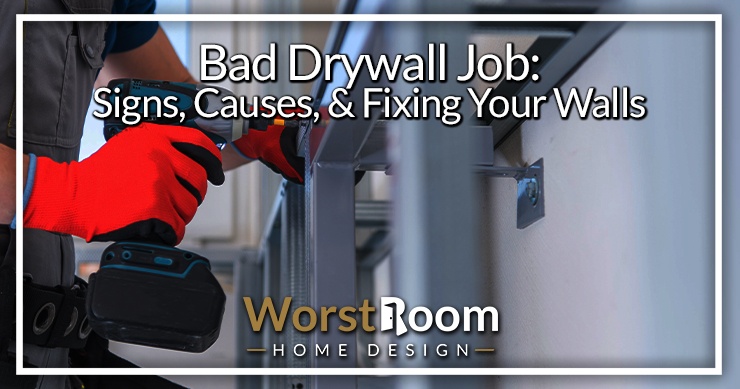
A bad drywall job can leave your home or commercial property looking unprofessional and unfinished. This causes issues such as nail pops, visible seams, uneven corners, and even moisture damage.
In today's blog post, we'll explore the signs of a poorly executed drywall installation and discuss the possible causes behind these problems. We'll also offer helpful tips on how to fix a bad drywall job.
Signs & Causes of a Bad Drywall Job
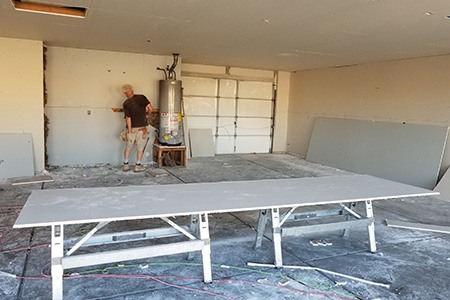
A bad drywall job can be identified by uneven surfaces, visible cracks and nail pops, sagging ceilings, poor finishing, and lack of experience or skill in workmanship due to the use of low-quality materials and improper installation methods.
Uneven Surfaces, Seams, & Corners
This can occur when skilled professionals do not carry out the installation process or when subpar materials are utilized.
Uneven surfaces might appear bumpy or wavy, making achieving a smooth paint finish difficult. Moreover, poorly aligned seams or improperly taped joints may lead to visible lines where panels meet. You may find yourself fixing bubbled drywall tape, spackling holes they painted over, etc.
For instance, imagine walking into a newly finished room and noticing that the corners are not straight or symmetrical. The crooked lines immediately catch your eye and detract from your space's overall design, whether you intended for them to be crisp and sleek industrial-style edges or elegantly curved archways.
Similarly, if you see noticeable bumps on what should be flat surfaces in rooms with minimalist designs, it's clear that something went wrong with the gypsum board installation process.
Visible Cracks, Nails, & Screw Pops
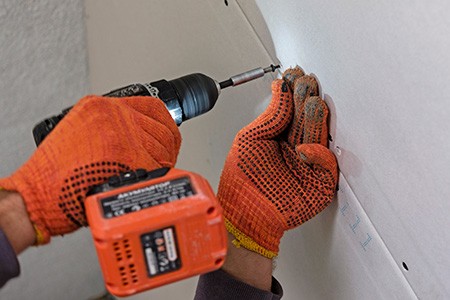
These unsightly imperfections not only compromise your walls' overall appearance but may also indicate underlying problems with the installation process itself.
For instance, visible cracks often result from poor seam work or inadequate taping and mudding. You may have drywall tape separating from the ceiling.
Nail and screw pops occur when fasteners used to attach drywall panels become loose or protrude from their original position due to various factors such as wood shrinkage, moisture changes in the air, or incorrect installation techniques like overdriving screws.
This leads to small bumps on your wall surfaces, which can be an eyesore and potentially damaging if left untreated.
Poor Finishing & Sagging Ceilings
Poor finishing and sagging ceiling issues often arise due to subpar workmanship, the use of low-quality materials, or improper installation techniques.
For instance, when an inadequate amount of drywall compound is applied on seams or if fasteners aren't properly covered, it can result in visually displeasing rough surfaces that may also become susceptible to long-term damage.
Sagging ceilings not only detract from the aesthetics of a space but also pose safety risks if they eventually collapse. One way homeowners can avoid these problems is by opting for alternative wall covering solutions such as Trusscore Wall&CeilingBoard – which boasts mold and bacteria resistance properties and compliance with building codes and standards.
Lack of Experience, Skill, & Poor Workmanship
When inexperienced contractors or those without the necessary skills attempt to install drywall, there is often an array of problems that can arise.
These mistakes can be easily made by those that do not have sufficient training or expertise in drywall installation. To ensure high-quality results when installing drywall, choose a qualified professional with years of experience in construction defects like surface preparation & plastering.
Use of Low-Quality Materials & Improper Installation Methods
It's important to ensure that your contractor uses high-quality drywall material from a reputable manufacturer. Not only will this make for a better-looking finish, but it will also help avoid issues with moisture damage or toxicity.
Low-quality materials may save you money upfront, but they can cost you more in repairs down the line. Improper installation methods such as inadequate taping, mud application, or finishing techniques can also result in poor quality outcomes that will affect the lifespan of your walls & ceilings.
How To Fix a Bad Drywall Job
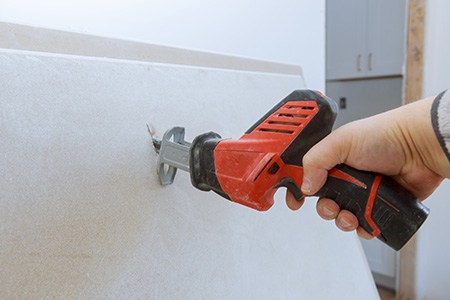
To fix a bad drywall job, it is essential to identify the problem areas, decide whether repair or replacement is necessary, use quality materials and tools, seek professional help, and consider decorative elements to cover up imperfections.
Identify Problem Areas and Decide Whether To Repair or Replace
Before attempting to fix a bad sheetrock job, it's essential to identify problem areas and determine whether repair or replacement is necessary. Some common signs of a bad drywall job include uneven surfaces, visible cracks, poor finishing, and sagging ceilings.
If these issues are present but not too severe, they might be able to be repaired with some simple patching and painting. However, a full replacement may be necessary if the damage is extensive or structural problems exist behind the walls. Once you paint a room, allow enough time to pass after painting before sleeping in a bedroom.
Use Quality Materials & Tools
Investing in top-notch joint compounds (versus spackle), sanding tools, and gypsum boards can yield better results and save you money in the long run. It's also important to ensure that your building materials come from reputable sources.
Choosing high-quality construction tools is equally vital when fixing a bad drywall job. For instance, a good sander with proper dust collection features helps reduce allergies caused by drywall dust while improving work speed.
Seek the Help of a Professional if Needed
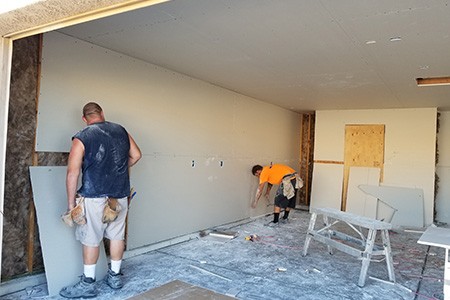
Fixing a bad drywall job can be time-consuming and challenging, especially if you lack experience or tools. In such cases, it is best to seek the help of a professional who can identify problem areas, offer solutions, and execute repairs with precision.
Professionals have years of experience working on walls and ceilings, including those with complicated shapes or surfaces. They also use specialized tools and high-quality materials that ensure seamless finishing and longevity.
Choosing a certified contractor ensures you avoid health hazards associated with toxic drywall installation while adhering to building codes and environmental sustainability standards.
Consider Decorative Elements To Cover Up Imperfections
If you're dealing with a bad drywall job leaving unsightly seams, cracks, or uneven surfaces on your walls and ceiling, there are some decorative solutions to consider.
One option is to use textured paint or wallpaper over the damaged areas. This can add depth and interest to your walls while hiding imperfections. Another solution is adding wainscoting or paneling to specific wall sections where issues may be most pronounced.
In addition to these options, Trusscore Wall&CeilingBoard is another alternative worth considering. The PVC panels provide a durable and moisture-resistant solution that you can easily install over existing drywall without needing specialized tools or experience.
It’s also chemical resistant, making it perfect for those areas in your home prone to spills, like bathrooms and kitchen backsplashes. Trusscore’s natural white finish gives you a sleek look that will brighten up any room.
How To Avoid a Bad Drywall Job
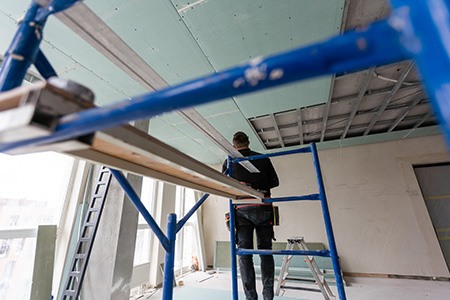
Below are ways to prevent a bad drywall job, which entirely revolve around asking quality questions and setting proper expectations between you and your contractor.
Choose a Qualified & Experienced Professional
A qualified and experienced professional knows how to properly install and finish drywall so that your walls look smooth and seamless.
Researching potential contractors, checking references, and clearly communicating your expectations are important steps in ensuring you choose someone who will do a good job.
Working with an unskilled or inexperienced contractor could result in a bad sheetrock job that may require costly repairs.
Research & Ask for References
Ask friends, family, or neighbors for recommendations, and check online reviews. Take the time to view their portfolio or previous work and ask about their experience level with drywall installation.
It's also vital to communicate your expectations clearly with the contractor before starting the project. Ensure they use quality materials and tools, such as gypsum board finish, drywall tape, joint compound, primer, and interior angles. You don’t want low-level employees cutting corners and taking shortcuts.
Ensure Quality Materials & Tools Are Used
Poor quality materials can result in sagging, cracking, and even toxic drywall, leading to health problems.
Ensure to only buy from certified sources in the US to avoid these issues. Additionally, depending on the environment where it will be installed, investing in moisture-resistant or impact-resistant drywall may be necessary.
Set Clear Expectations & Communicate With Your Contractor
Before beginning any renovation project, discuss what you envision for the result. This includes discussing timelines, budgets, materials, and any unique design choices you want to incorporate into your space. Additionally, be open and honest about any concerns or questions you may have throughout the process.
Your contractor should also communicate with you regarding their experience level and skill in drywall installation. Ensure they are familiar with local building codes and standards so that all work completed meets safety requirements.
A Bad Drywall Job is Avoidable & Fixable
A bad drywall job can cause headaches and frustration for homeowners. Signs of a poor installation include uneven surfaces, visible cracks, and sagging ceilings which can lead to more severe issues like moisture damage and mold growth.
To fix this issue, it is important to identify problem areas early on and seek the help of qualified professionals if needed. When choosing building materials such as drywall or PVC wall panels like Trusscore Wall&Ceiling Board, research quality products resistant to bacteria, mold, and moisture damage. These will help prevent a bad drywall job.



